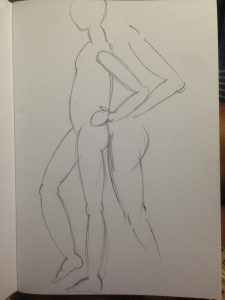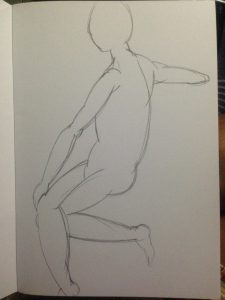Today we were taught another method instead of using the rectilinear blocks method – drawing with curve lines. This was harder for me than the rectilinear blocks somehow. So we tried this with the same female model as last week to pose 2 simple poses.
I prefer my second try. I think it was easier for me as the model had a more dynamic pose. Which I felt was more befitting of using curves to illustrate as the curve line enhances the movements. Another reason could be that the tension and relaxed lines of the body is more apparent in a dynamic than straight pose hence it was easier to draw for me.
We were taught about how our eyes moved from one subject matter to another. Our compositions are such that our eyes would move in a certain manner as dictated by the artist.
Chinese painting techniques “squash” everything into a stacking layer. The higher the layer, the more background it is. The lower it is on the paper, the more foreground it is. This greatly distorts perspectives.
Even Degas, uses that in his famous ballerina composition. Notice how your eyes move from the bottom left, to the full ballerina dancing in the center, up her overly long left arm to the background dancers standing around.
So we were task to first draw the model anywhere on a A2 size paper. After which we were to join another A2 paper either side by side or one top of the first one. From there we were to selectively draw the surroundings as we deem fit in our composition. The goal is to ensure a fluidity of movements from one subject matter to another. After that, we were to add a 3rd A2 paper. Prof said this was an easier assignment than last week. However I beg to differ as this was much harder for me and I didn’t enjoy this week as much as the last. Prof also taught us a trick to dictate eye movements by erasing certain areas of the subject matter. This allows a path for the viewer to move around the painting. Empty spaces are equally important in guiding the eye and creating space in compositions.
I forgot to take photo of my final work that I handed in, I’ll upload it when I receive it.
Hence at the end of the lesson, I learn that as much as perspectives are helpful in making the subjects look real. It is not the be all and end all. Our eyes don’t strictly see in perspectives, and our brains mess around with our viewing in that it compensates the “shock”. And these are all perfectly fine. It’s not a hard and fast route, artists like Degas, Michelangelo also distorts perspectives to achieve their intended goals.



